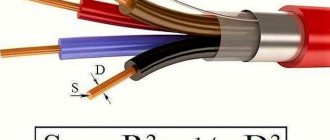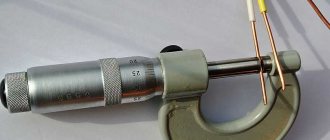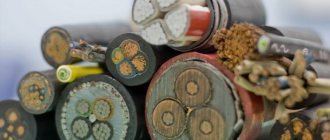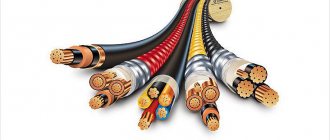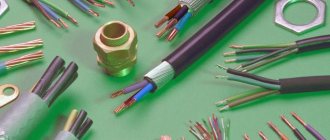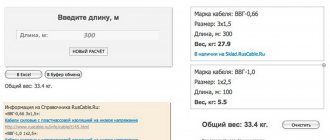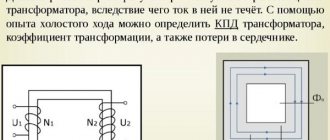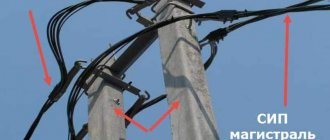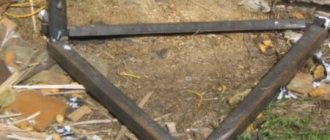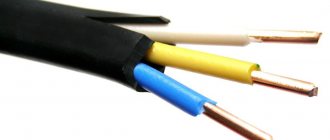Are you planning to modernize the electrical network or extend an additional power line to the kitchen to connect a new electric stove? Here, minimal knowledge about the cross-section of the conductor and the effect of this parameter on power and current will be useful.
Agree that incorrect calculation of the cable cross-section leads to overheating and short circuit or to unjustified costs.
It is very important to carry out calculations at the design stage, since the failure of hidden wiring and subsequent replacement is associated with significant costs. We will help you understand the intricacies of calculations in order to avoid problems in the further operation of electrical networks.
In order not to burden you with complex calculations, we have selected clear formulas and calculation options, presented the information in an accessible form, and provided the formulas with explanations. Thematic photos and video materials have also been added to the article, allowing you to clearly understand the essence of the issue under consideration.
Selection of conductor cross-section by power and length
The length of the conductor determines the voltage supplied to the end point.
A situation may arise when the voltage at the point of consumption is insufficient to operate electrical appliances. In household electrical communications, these losses are neglected and a cable is used ten to fifteen centimeters longer than necessary. This surplus is spent on switching. When connected to a distribution board, the reserve is increased, taking into account the need to connect circuit breakers.
Cable laid in a closed waySource kadetbrand.ru
When laying long lines, one should take into account the inevitable voltage drop. Everyone has their own resistance, which is influenced by three main factors:
- Length measured in meters. As this indicator increases, losses increase.
- Cross section, measured in square millimeters. If this parameter is increased, the voltage drop decreases.
- The resistance of the conductor material, the value of which is taken from the reference data. They show the reference resistance of a wire with a cross-section of one millimeter and a length of one meter.
The product of resistance and current numerically represents the voltage drop. This value should not exceed five percent. If it exceeds this figure, then it is necessary to take a conductor with a larger cross-section.
More information on how to calculate cable cross-section in the video:
Section calculation using formulas
The selection algorithm is as follows:
The conductor area along the length and maximum power is calculated using the formula:
Source infopedia.su
Where:
P – power;
U – voltage;
cosф – coefficient.
For household electrical networks, the coefficient value is equal to one. For industrial communications, it is calculated as the ratio of active power to total power.
- The PUE table contains the current cross section.
- Wiring resistance is calculated:
Source textarchive.ru
Where:
ρ – resistance;
l – length;
S – cross-sectional area.
At the same time, do not forget that the current moves in both directions and in fact the resistance is equal to:
Source textarchive.ru
The voltage drop corresponds to the relationship:
Source moypatent.ru
In percentage terms, the voltage drop is as follows:
Source tex.stackovernet.com
If the result exceeds five percent, then the nearest cross section with a larger value is searched in the directory.
Such calculations are rarely performed by generic electricity consumers. There are specialized specialists and a lot of reference material for this. Moreover, there are many online calculators on the Internet, with the help of which all calculations can be made in a couple of clicks.
Visually calculate the cable cross-section using the formulas in the video:
Section and installation method
Another factor that influences the choice of conductor cross-section is the method of laying the lines. There are two of them:
- open;
- closed.
In the first method, the wiring is placed in a special box or corrugated pipe and is located on the wall surface. The second option involves embedding the cable inside the decoration or main body of the walls.
Here the thermal conductivity of the environment plays a major role. In the ground, heat is removed from the cable better than in air. Therefore, with the closed method, wires with a smaller cross-section are taken than with the open method. The table below shows how the laying method affects the cross-section of the conductor.
Laying method and conductor cross-section Source m-strana.ru
Features of calculating the power of hidden wiring
The calculation for hidden wiring is different than for exposed cables.
It all depends on changes in the properties of conductors and their insulation in a closed space. If the conductor is located on the surface and is in contact with air, it has a greater opportunity to release the generated heat, maintaining a low temperature. Densely packed wires cannot cool as well due to the lack of circulating air, so they heat up more intensely.
The first rule for installing hidden wiring states that it is necessary to carry out calculations with a margin of approximately 20-30% in order to avoid overheating during operation. According to the second standard, the presence of several conductors in one channel requires a margin of at least 40%.
IMPORTANT: The only correct way to calculate the cable cross-section is the power consumption value.
It is not recommended to lay cables tightly; it is better to equip a separate corrugated pipe for each of the independent wires.
Pivot table
There are tables that allow you to determine the required cross-section using several parameters at once - current, power, conductor material, and so on. They are more convenient to use and one of them is located below. It indicates the cross-section of the wire in terms of current and power, and also takes into account the installation method.
Wire cross-section by current and power - table for copper and aluminum conductorsSource tvz2.ru
Perhaps the article came out a little boring and full of technical terms. However, the information contained in it should not be neglected. Since the reliability and safety of the functioning of the home electrical network depends on how correctly the wiring was chosen.
We measure the cross-section of wires depending on the diameter
The cross-section of a cable or other types of conductors is determined in several ways. The main thing is to take care of preliminary measurements. To do this, it is recommended to remove the top layer of insulation.
About measuring instruments, description of the process
Calipers and micrometers are the main tools that help in measurements. Most often, preference is given to devices of the mechanical group. But it is also permissible to choose electronic analogues. Their main difference is digital special screens.
Electronic caliper
Vernier calipers are among the tools found in every household. Therefore, it is often chosen when measuring the diameter of wires and cables. This also applies to cases where the network continues to operate - for example, inside an outlet or panel device.
The following formula helps determine the cross-section based on the diameter:
S = (3.14/4)*D2.
D is a letter indicating the diameter of the wire.
If there is more than one core in the structure, then measurements are carried out for each of the component elements separately. After this, the results obtained are added to each other.
Then everything can be calculated using the following formula:
Stotal= S1+ S2+…
Stotal is an indication of the total cross-sectional area.
S1, S2 and so on are the cross sections defined for each of the cores.
It is recommended to measure the parameter at least three times to ensure accurate results. The conductor is turned in different directions every time. The result is an average value that is as close as possible to reality.
A regular ruler can be used if a caliper or micrometer is not at hand. The following manipulations are expected to be performed:
- Complete cleaning of the insulation layer near the core.
- Winding the turns around the pencil, as tightly as possible to each other. The minimum number of such components is 15-17 pieces.
- The winding is measured by its overall length.
- The final value is divided by the number of turns.
The accuracy of the measurement is questionable if the turns do not fit evenly on the pencil, leaving gaps of certain sizes. To ensure higher accuracy, it is recommended to measure the product from different sides. It is difficult to wind thick strands onto regular pencils. It is still better to use calipers.
The cross-sectional area of the wire is calculated using the formula described earlier. This is done after completing the main measurements. You can rely on special tables.
The micrometer is recommended to be used in cases where the composition contains ultra-thin conductors. Otherwise, there is a high probability of mechanical damage.
Table of correspondence of wire diameters and their cross-sectional area
Three main ways to determine wire diameter
There are several methods, but each of them is based on determining the diameters of the core with subsequent calculations of the final results.
Method one. Using instruments. Today there are a number of instruments that help measure the diameter of a wire or wire strand. This is a micrometer and caliper, which come in both mechanical and electronic (see below).
This option is primarily suitable for professional electricians who are constantly installing electrical wiring. The most accurate results can be obtained using a caliper. This technique has the advantage that it is possible to measure the wire diameter even on a section of a working line, for example, in a socket.
After you have measured the diameter of the wire, you need to make calculations using the following formula:
It must be remembered that the number “Pi” is 3.14, so if we divide the number “Pi” by 4, we can simplify the formula and reduce the calculation to multiplying 0.785 by the diameter squared.
Method two. We use a ruler. If you decide not to spend money on a device, which is logical in this situation, then you can use a simple proven method for measuring the cross-section of a wire or wire?. You will need a simple pencil, ruler and wire. Strip the core of insulation, wind it tightly onto a pencil, and then use a ruler to measure the total length of the winding (as shown in the figure).
Then divide the length of the wound wire by the number of cores. The resulting value will be the diameter of the wire cross-section.
But the following must be taken into account:
- the more cores you wind on a pencil, the more accurate the result will be; the number of turns should be at least 15;
- press the coils tightly against each other so that there is no free space between them, this will significantly reduce the error;
- take measurements several times (change the measuring side, the direction of the ruler, etc.). Several results obtained will again help you avoid a large error.
Please note the disadvantages of this measurement method:
- You can only measure the cross-section of thin wires, since it will be difficult for you to wind a thick wire around a pencil.
- To begin with, you will need to purchase a small piece of the product before making the main purchase.
The formula discussed above is suitable for all measurements.
Method three. We use the table. In order not to carry out calculations using the formula, you can use a special table that indicates the diameter of the wire? (in millimeters) and conductor cross-section (in square millimeters). Ready-made tables will give you more accurate results and will significantly save your time, which you will not have to spend on calculations.
| Conductor diameter, mm | Conductor cross-section, mm² |
| 0.8 | 0.5 |
| 1 | 0.75 |
| 1.1 | 1 |
| 1.2 | 1.2 |
| 1.4 | 1.5 |
| 1.6 | 2 |
| 1.8 | 2.5 |
| 2 | 3 |
| 2.3 | 4 |
| 2.5 | 5 |
| 2.8 | 6 |
| 3.2 | 8 |
| 3.6 | 10 |
| 4.5 | 16 |
Dependence of current, power and core cross-section
When choosing a cable, you must be guided by several criteria:
- the strength of the electric current that the cable will pass;
- power consumed by energy sources;
- current load exerted on the cable.
Power
The most important parameter during electrical installation work (in particular, cable laying) is throughput. The maximum power of electricity transmitted through it depends on the cross-section of the conductor.
Therefore, it is extremely important to know the total power of the energy consumption sources that will be connected to the wire
Typically, manufacturers of household appliances, appliances and other electrical products indicate on the label and in the documentation accompanying them the maximum and average power consumption. For example, a washing machine can consume electricity ranging from tens of W/h during rinsing mode to 2.7 kW/h when heating water.
The average power of all electrical appliances and lighting devices in an apartment rarely exceeds 7500 W for a single-phase network. Accordingly, the cable cross-sections in the electrical wiring must be selected to this value.
On a note. It is recommended to round the cross-section towards higher power due to a possible increase in power consumption in the future. Typically, the next largest cross-sectional area from the calculated value is taken.
So, for a total power of 7.5 kW, it is necessary to use a copper cable with a core cross-section of 4 mm2, which is capable of transmitting about 8.3 kW. The cross-section of the conductor with an aluminum core in this case must be at least 6 mm2, passing a current power of 7.9 kW.
Marking labels for electrical appliances and household appliances indicating their rated power
Electric current
Often the power of electrical equipment and equipment may not be known to the owner due to the absence of this characteristic in the documentation or completely lost documents and labels. There is only one way out in such a situation - to calculate using the formula yourself.
P = U*I, where:
- P – power, measured in watts (W);
- I – electric current strength, measured in amperes (A);
- U is the applied electrical voltage, measured in volts (V).
When the strength of the electric current is unknown, it can be measured with control and measuring instruments: an ammeter, a multimeter, and a clamp meter.
Measuring current with clamp meters
After determining the power consumption and electric current, you can use the table below to find out the required cable cross-section.
Load
Calculation of the cross-section of cable products based on current load must be carried out to further protect them from overheating. When too much electric current passes through conductors for their cross-section, destruction and melting of the insulating layer can occur.
The maximum permissible long-term current load is the quantitative value of the electric current that can pass the cable for a long time without overheating. To determine this indicator, it is initially necessary to sum up the powers of all energy consumers. After this, calculate the load using the formulas:
- I = P∑*Ki/U (single-phase network),
- I = P∑*Kи/(√3*U) (three-phase network), where:
- P∑ – total power of energy consumers;
- Ki – coefficient equal to 0.75;
- U – electrical voltage in the network.
| Section of cable and wire products | Electrical voltage 220 V | Electrical voltage 380 V | ||
| Current strength, A | power, kWt | Current strength, A | power, kWt | |
| 2,5 | 27 | 5,9 | 25 | 16,5 |
| 4 | 38 | 8,3 | 30 | 19,8 |
| 6 | 50 | 11 | 40 | 26,4 |
| 10 | 70 | 15,4 | 50 | 33 |
| 16 | 90 | 19,8 | 75 | 49,5 |
| 25 | 115 | 25,3 | 90 | 59,4 |
| 35 | 140 | 30,8 | 115 | 75,9 |
| 50 | 175 | 38,5 | 145 | 95,7 |
| 70 | 215 | 47,3 | 180 | 118,8 |
| 95 | 260 | 57,2 | 220 | 145,2 |
| 120 | 300 | 66 | 260 | 171,6 |
Determining the cross-section of a cable product is a particularly important process in which miscalculations are unacceptable. You need to take into account all factors, parameters and rules, trusting only your calculations. The measurements taken must coincide with the tables described above - if they do not contain specific values, they can be found in the tables of many electrical engineering reference books.
Current Density
For copper cable with a core cross-section of 1 sq. mm, the average value of this indicator varies from 6 to 10 A. For copper wiring with a cross-section of 1 sq. mm, a current of 6-10 A can flow without overheating or melting of the insulating coating. According to PEU standards, a 40% margin is added to protect against possible overheating of the shells.
The lower limit of 6 A allows the use of wiring without time restrictions, the upper limit of 10 A is the permissible values of short-term loads on the network. An increase in current strength to a value of 12 A (more than the upper limit for the selected section) leads to an increase in current density, its overheating, followed by melting of the protective shell.
Wire diameter measurement
According to the standard, the diameter of the wire must correspond to the declared parameters, which are described in the marking. But the actual size may differ from the declared one by 10-15 percent. This is especially true for cables that are manufactured by small companies, but large manufacturers can also have problems. Before purchasing an electrical wire for transmitting large currents, it is recommended to measure the diameter of the conductor. For this purpose, various methods can be used, differing in error. Before performing measurements, it is necessary to remove insulation from the cable cores.
Measurements can be made directly in the store if the seller allows you to remove the insulation from a small section of the wire. Otherwise, you will have to purchase a small piece of cable and take measurements on it.
Micrometer
Maximum accuracy can be achieved using micrometers that have a mechanical and electronic circuit. On the shaft of the instrument there is a scale with a division value of 0.5 mm, and on the circle of the drum there are 50 marks with a division value of 0.01 mm. The characteristics are the same for all micrometer models.
When working with a mechanical device, the following sequence of actions should be followed:
- By rotating the drum, the gap between the screw and the heel is set close to the measured size.
- Use a ratchet to bring the screw closer to the surface of the part being measured. The eyeliner is performed by rotating the hand without effort until the ratchet operates.
- Calculate the transverse diameter of the part according to the readings on the scales located on the stem and drum. The diameter of the product is equal to the sum of the values on the rod and the drum.
Mechanical micrometer measurement
Working with an electronic micrometer does not require rotation of the units; it displays the diameter value on the liquid crystal screen. It is recommended to check the settings before using the device as electronic devices measure in millimeters and inches.
Vernier caliper
The device has reduced accuracy compared to a micrometer, which is quite sufficient for measuring a conductor. Vernier calipers are equipped with a flat scale (vernier), a circular dial or a digital display on a liquid crystal display.
To measure the transverse diameter, you must:
- Clamp the conductor to be measured between the jaws of the caliper.
- Calculate the value on the scale or view it on the display.
An example of calculating size on a vernier
Ruler
Measuring with a ruler gives a rough result. To perform measurements, it is recommended to use tool rulers, which have greater accuracy. Using wooden and plastic school products will give a very approximate diameter value.
To measure with a ruler you need:
- Remove insulation from a piece of wire up to 100 mm long.
- Wind the resulting piece tightly around a cylindrical object. The turns must be complete, that is, the beginning and end of the wire in the winding are directed in one direction.
- Measure the length of the resulting winding and divide by the number of turns.
Measuring the diameter with a ruler by the number of turns
In the example above there are 11 turns of wire which are about 7.5mm in length. By dividing the length by the number of turns, you can determine the approximate value of the diameter, which in this case is 0.68 mm.
On the websites of stores selling electrical wires, there are online calculators that allow you to calculate the cross-section based on the number of turns and the length of the resulting spiral.
Section according to GOST or TU
A large assortment of electrical products helps to quickly solve problems associated with electrical installation work. The quality of these products plays a very important role and all products must comply with GOST requirements.
Often, manufacturers, wanting to save money, find loopholes to deviate from GOST requirements and themselves develop technical production conditions (TU) taking into account the permitted errors.
As a result, the market is oversaturated with low-quality and cheap goods that need to be double-checked before purchasing.
If the cables available in retail outlets of a suitable price do not correspond to the declared characteristics, the only thing that can be done is to purchase a wire with a reserve cross-section. Power reserve will never negatively affect the quality of electrical wiring
It would also be useful to pay attention to products from manufacturers who value their name - although they are more expensive, they are a guarantee of quality, and wiring replacement is not done so often that you can save on it
General information about cable and wire
When working with conductors, it is necessary to understand their designation. There are wires and cables that differ from each other in their internal structure and technical characteristics. However, many people often confuse these concepts.
A wire is a conductor that has in its design one wire or a group of wires woven together and a thin common insulating layer. A cable is a core or a group of cores that has both its own insulation and a common insulating layer (sheath).
Each type of conductor will have its own methods for determining cross sections, which are almost similar.
Conductor materials
The amount of energy that a conductor transmits depends on a number of factors, the main one of which is the material of the current-carrying conductors. The following non-ferrous metals can be used as the core material of wires and cables:
- Aluminum. Cheap and lightweight conductors, which is their advantage. They are characterized by such negative qualities as low electrical conductivity, a tendency to mechanical damage, high transient electrical resistance of oxidized surfaces;
- Copper. The most popular conductors, which have a high cost compared to other options. However, they are characterized by low electrical and transition resistance at the contacts, fairly high elasticity and strength, and ease of soldering and welding;
- Aluminum copper. Cable products with aluminum cores coated with copper. They are characterized by slightly lower electrical conductivity than their copper counterparts. They are also characterized by lightness, average resistance and relative cheapness.
Different types of cables based on core material
Important! Some methods for determining the cross-section of cables and wires will depend specifically on the material of their conductor component, which directly affects the throughput power and current strength (method for determining the cross-section of conductors by power and current)
Wire material
As you know, copper and aluminum wires have different resistance, as well as different service life, from which we can conclude that calculations on the power or current of their cross-section must be made separately.
Copper wire, as already mentioned, requires less thickness than aluminum, with the same load on the cable, and here's why. The resistivity of aluminum is higher than that of copper, and therefore the current losses are greater. And it is precisely due to this that the cable heats up, since household electrical appliances do not understand through what material the voltage is applied to them. They take exactly as much as they need.
But copper, which has a resistance equal to 0.017 Ohm*kV mm/m. consumes less electricity for heating than aluminum with its resistivity of 0.028 Ohm*sq. Mmm. As a result, the copper heats up less, the wire needed is thinner, and the efficiency of the copper cable is higher.
This is why, despite the high cost compared to aluminum, copper wires are more in demand in the electrical engineering market.
The difference between wire sizes for 220 and 380 volts
Calculation of the cross-section of electrical wiring according to the power of connected electrical appliances
To select the cross-section of cable wire cores when laying electrical wiring in an apartment or house, you need to analyze the fleet of existing electrical household appliances from the point of view of their simultaneous use. The table provides a list of popular household electrical appliances indicating the current consumption depending on the power.
You can find out the power consumption of your models yourself from the labels on the products themselves or data sheets; often the parameters are indicated on the packaging. If the current consumed by an electrical appliance is not known, it can be measured using an ammeter.
Typically, the power consumption of electrical appliances is indicated on the housing in watts (W or VA) or kilowatts (kW or kVA). 1 kW=1000 W.
Table of power/current consumption of household electrical appliances
| electrical appliance | Power consumption, W | Current strength, A |
| Washing machine | 2000 – 2500 | 9,0 – 11,4 |
| Jacuzzi | 2000 – 2500 | 9,0 – 11,4 |
| Electric floor heating | 800 – 1400 | 3,6 – 6,4 |
| Stationary electric stove | 4500 – 8500 | 20,5 – 38,6 |
| microwave | 900 – 1300 | 4,1 – 5,9 |
| Dishwasher | 2000 – 2500 | 9,0 – 11,4 |
| Freezers, refrigerators | 140 – 300 | 0,6 – 1,4 |
| Electric meat grinder | 1100 – 1200 | 5,0 – 5,5 |
| Electric kettle | 1850 – 2000 | 8,4 – 9,0 |
| Electric coffee maker | 630 – 1200 | 3,0 – 5,5 |
| Juicer | 240 – 360 | 1,1 – 1,6 |
| Toaster | 640 – 1100 | 2,9 – 5,0 |
| Mixer | 250 – 400 | 1,1 – 1,8 |
| Hairdryer | 400 – 1600 | 1,8 – 7,3 |
| Iron | 900 –1700 | 4,1 – 7,7 |
| Vacuum cleaner | 680 – 1400 | 3,1 – 6,4 |
| Fan | 250 – 400 | 1,0 – 1,8 |
| TV | 125 – 180 | 0,6 – 0,8 |
| Radio equipment | 70 – 100 | 0,3 – 0,5 |
| Lighting devices | 20 – 100 | 0,1 – 0,4 |
Current is also consumed by the refrigerator, lighting fixtures, radiotelephone, chargers, and TV in standby mode. But in total this power is no more than 100 W and can be ignored in calculations.
If you turn on all the electrical appliances in the house at the same time, you will need to select a wire cross-section capable of passing a current of 160 A. You will need a finger-thick wire! But such a case is unlikely. It’s hard to imagine that someone is capable of grinding meat, ironing, vacuuming and drying hair at the same time.
Calculation example. You got up in the morning, turned on the electric kettle, microwave, toaster and coffee maker. The current consumption will accordingly be:
7 A + 8 A + 3 A + 4 A = 22 A
Taking into account the switched on lighting, refrigerator and, in addition, for example, a TV, the current consumption can reach 25 A.
Selecting a wire cross-section for connecting electrical appliances to a three-phase 380 V network
When operating electrical appliances, for example, an electric motor, connected to a three-phase network, the consumed current no longer flows through two wires, but through three and, therefore, the amount of current flowing in each individual wire is somewhat less. This allows you to use a smaller cross-section wire to connect electrical appliances to a three-phase network.
To connect electrical appliances to a three-phase network with a voltage of 380 V, for example an electric motor, the wire cross-section for each phase is taken 1.75 times less than for connecting to a single-phase network of 220 V
Attention, when choosing a wire cross-section for connecting an electric motor based on power, you should take into account that the nameplate of the electric motor indicates the maximum mechanical power that the motor can create on the shaft, and not the electrical power consumed
For example, you need to connect an electric motor that consumes power from a 2.0 kW network. The total current consumption of an electric motor of such power in three phases is 5.2 A. According to the table, it turns out that a wire with a cross-section of 1.0 mm2 is needed, taking into account the above 1.0 / 1.75 = 0.5 mm2. Therefore, to connect a 2.0 kW electric motor to a three-phase 380 V network, you will need a three-core copper cable with a cross-section of each core of 0.5 mm2.
It is much easier to choose the wire cross-section for connecting a three-phase motor based on the current consumption, which is always indicated on the nameplate. For example, the current consumption of a 0.25 kW motor for each phase at a supply voltage of 220 V (the motor windings are connected in a delta configuration) is 1.2 A, and at a voltage of 380 V (the motor windings are connected in a star configuration) it is only 0.7 A.
Taking the current strength indicated on the nameplate, according to the table for selecting the wire cross-section for apartment electrical wiring, we select a wire with a cross-section of 0.35 mm2 when connecting the electric motor windings in a “triangle” pattern or 0.15 mm2 when connecting in a “star” pattern.
Cable device
To better understand the process of calculating a conductor cross-section depending on the power of the current consumed, it is necessary to understand the essence of the process of transmitting electricity. For clarity, it is better to imagine several thin water pipes that must be placed parallel to each other along the circumference.
The wider this circle, the greater the number of such pipes that will fit in a dense arrangement. The output pressure of a large system will be much greater than that of a small one. With electricity, too, because current flows across the surface of the conductor, thick cables will be able to support larger loads.
Incorrect calculation of the power cross section is performed when:
- The current-carrying wire is too wide. Wiring costs increase significantly, and cable resources are used irrationally.
- The width of the current-carrying channel is less than required. The current density increases, heating the conductor and insulation, which leads to electrical leakage and the formation of “weak spots” on the cable, increasing the fire hazard of the wiring.
In the first case, there is no danger to life, but the material costs are unreasonably high.
How to calculate cable cross-section by power?
First step. The total power of all electrical appliances that can be connected to the network is calculated:
Psum = (P1 + P2 + .. + Pn) × Kс
- P1, P2 .. – power of electrical appliances, W;
- Kc – demand coefficient (probability of simultaneous operation of all devices), default is 1.
Second step. Then the rated current in the circuit is determined:
I = Psum / (U × cos ϕ)
- Psum – total power of electrical appliances;
- U – network voltage;
- cos ϕ – power factor (characterizes power losses), default is 0.92.
Third step. At the last stage, tables are used in accordance with the PUE (Electrical Installation Rules).
Table of copper cable cross-section by current according to PUE-7
| Conductor cross-section, mm2 | Current, A, for wires laid | |||||
| open | in one pipe | |||||
| two single-core | three single-core | four single-core | one two-wire | one three-wire | ||
| 0.5 | 11 | — | — | — | — | — |
| 0.75 | 15 | — | — | — | — | — |
| 1 | 17 | 16 | 15 | 14 | 15 | 14 |
| 1.2 | 20 | 18 | 16 | 15 | 16 | 14.5 |
| 1.5 | 23 | 19 | 17 | 16 | 18 | 15 |
| 2 | 26 | 24 | 22 | 20 | 23 | 19 |
| 2.5 | 30 | 27 | 25 | 25 | 25 | 21 |
| 3 | 34 | 32 | 28 | 26 | 28 | 24 |
| 4 | 41 | 38 | 35 | 30 | 32 | 27 |
| 5 | 46 | 42 | 39 | 34 | 37 | 31 |
| 6 | 50 | 46 | 42 | 40 | 40 | 34 |
| 8 | 62 | 54 | 51 | 46 | 48 | 43 |
| 10 | 80 | 70 | 60 | 50 | 55 | 50 |
| 16 | 100 | 85 | 80 | 75 | 80 | 70 |
| 25 | 140 | 115 | 100 | 90 | 100 | 85 |
| 35 | 170 | 135 | 125 | 115 | 125 | 100 |
| 50 | 215 | 185 | 170 | 150 | 160 | 135 |
| 70 | 270 | 225 | 210 | 185 | 195 | 175 |
| 95 | 330 | 275 | 255 | 225 | 245 | 215 |
| 120 | 385 | 315 | 290 | 260 | 295 | 250 |
| 150 | 440 | 360 | 330 | — | — | — |
| 185 | 510 | — | — | — | — | — |
| 240 | 605 | — | — | — | — | — |
| 300 | 695 | — | — | — | — | — |
| 400 | 830 | — | — | — | — | — |
Table of cross-section of aluminum cable by current according to PUE-7
| Conductor cross-section, mm2 | Current, A, for wires laid | |||||
| open | in one pipe | |||||
| two single-core | three single-core | four single-core | one-two-core | one three-wire | ||
| 2 | 21 | 19 | 18 | 15 | 17 | 14 |
| 2.5 | 24 | 20 | 19 | 19 | 19 | 16 |
| 3 | 27 | 24 | 22 | 21 | 22 | 18 |
| 4 | 32 | 28 | 28 | 23 | 25 | 21 |
| 5 | 36 | 32 | 30 | 27 | 28 | 24 |
| 6 | 39 | 36 | 32 | 30 | 31 | 26 |
| 8 | 46 | 43 | 40 | 37 | 38 | 32 |
| 10 | 60 | 50 | 47 | 39 | 42 | 38 |
| 16 | 75 | 60 | 60 | 55 | 60 | 55 |
| 25 | 105 | 85 | 80 | 70 | 75 | 65 |
| 35 | 130 | 100 | 95 | 85 | 95 | 75 |
| 50 | 165 | 140 | 130 | 120 | 125 | 105 |
| 70 | 210 | 175 | 165 | 140 | 150 | 135 |
| 95 | 255 | 215 | 200 | 175 | 190 | 165 |
| 120 | 295 | 245 | 220 | 200 | 230 | 190 |
| 150 | 340 | 275 | 255 | — | — | — |
| 185 | 390 | — | — | — | — | — |
| 240 | 465 | — | — | — | — | — |
| 300 | 535 | — | — | — | — | — |
| 400 | 645 | — | — | — | — | — |
In the Electrical Installation Rules, 7th edition, there are no tables of cable cross-section by power, there is only data on current strength. Therefore, when calculating sections using load tables on the Internet, you risk getting incorrect results.
Cable selection according to PUE and GOST tables
When purchasing a wire, it is recommended to look at the GOST standard or the technical specifications according to which the product is manufactured. GOST requirements are higher than similar parameters of technical specifications, so you should prefer products made according to the standard.
Tables from the rules for electrical installations (PUE) represent the dependence of the strength of the current transmitted through the conductor on the cross-section of the conductor and the method of installation in the main pipe. The permissible current decreases as the individual cores increase in size or as multi-core cable insulation is used. The phenomenon is associated with a separate clause in the PUE, which stipulates the parameters of the maximum permissible heating of the wires. The main pipe is understood as a box, including a plastic one or when laying wiring in a bundle on a cable tray.
Loading …
The parameters in the tables are indicated taking into account the operating temperature of the core of 65 ° C and only phase wires (zero buses are not taken into account). If a standard three-core cable for supplying single-phase current is laid in a room pipe, then its parameters are taken into account in the data column for one two-core wire. Below is information for cables made from different materials. Please note that the tables are used to select wires. In the case of determining the type of cables, other data is used, which is also available in the PUE.
The second way to select a cable is the tables of the GOST 16442-80 standard, which exist in two versions - for copper and. In this information, the choice is made depending on the type of laying and the number of cores in the cables.
What affects the heating of wires?
The reason for overheating of the wiring may lie in various network problems, so for correct calculation you need to know the main “weak points” of the cables, due to which their temperature rises. When current passes through metal, the material always heats up, but reducing this parameter is achieved by different methods.
The wires get hot, depending on:
- The quality and material of the insulating coating do not meet the required parameters. Low-quality dielectric material of cable sheaths is easily destroyed by thermal effects upon direct contact, conducting heat better.
- What wiring method was used? For open wires, the heating rate is much lower than for tightly “packed” wires in a closed plastic pipe.
- The type lived in the cable. There are stranded and single-core. The difference is that single-core wire of the same cross-section can withstand more current than several thinner wires, although multi-core cable is more flexible and easier to install.
- Core material. The amount of heating depends on the physical properties of the metal. Copper has a lower resistance than aluminum, so it heats up less and can transmit currents of higher voltage and strength with the same cross-section.
- Cable cross-sectional area. Everyone studied the skin effect at school - the flow of electric current along the surface of a conductor. The larger the cross-sectional area, the larger the surface area over which electricity is transmitted, so thick wires are capable of transmitting significant loads, while thin wires with such indicators simply burn out.
Why do you need to specify cable cross-sections?
On most wires and cables, the manufacturer is required to apply markings indicating their type, the number of conductors and their cross-section. If the wire is marked as 3x2.5, this means that the diameter of the wire is 2.5 mm². Actual values may differ from those indicated by approximately 30%, because some types of wiring (in particular PUNP) are produced according to outdated standards, which allow an error of the indicated number of percent and generally it appears on the smaller side. As a result, if you use a cable with a smaller cross-section than the calculated one, then the effect for the wire will be approximately the same if a thin polyethylene hose were connected to a fire hydrant. This can lead to dangerous consequences: overheating of the electrical wiring, melting of the insulation, and changes in the properties of the metal. Therefore, before making a purchase, it is imperative to check that the cross-sectional area of the conductor does not differ from that declared by the manufacturer.
Ways to find out the real diameter of the wire
The easiest and most accurate method to measure the diameter of a wire strand is to use special tools such as a caliper or micrometer (electronic or mechanical). In order for the measurement to be accurate, the wire being measured must be cleared of insulation so that the tool does not cling to it. You also need to inspect the tip of the wire so that it is free of kinks - sometimes they appear if the wire is cut through with blunt pliers. Once the diameter is measured, you can begin to calculate the cross-sectional area of the wire core.
A micrometer will give a more reliable reading than a caliper.
If you don’t have an accurate measuring tool at hand, there is another way to find out the cross-section - you will need a screwdriver (pencil or any tube) and a measuring ruler. You will also have to buy at least one meter of wire (50 cm is enough, if they sell that much) and remove the insulation from it. Next, the wire is wound tightly, without gaps, onto the tip of a screwdriver and the length of the wound section is measured with a ruler. The resulting winding width is divided by the number of turns and the result will be the required diameter of the wire, by which you can already search for the cross-section.
How to take measurements is shown in detail in this video:
What formulas should you use?
What such a cross-section of a wire is known from the basics of geometry or drawing is the intersection of a three-dimensional figure with an imaginary plane. At the points of their contact, a flat figure is formed, the area of which is calculated by suitable formulas. The wire core is most often cylindrical in shape and has a circle in cross-section; accordingly, the cross-section of the conductor can be calculated using the formula:
S = ϖ R²
R – radius of the circle, equal to half the diameter;
ϖ = 3.14
There are wires with flat conductors, but there are few of them and it is much easier to find the cross-sectional area of them - just multiply the sides.
To get a more accurate result you need to keep in mind:
- The more turns (there should be at least 15) screwed onto the screwdriver, the more accurate the result will be;
- There should be no distance between the turns; due to the gap, the error will be higher;
- You need to take several measurements, changing its beginning each time. The more there are, the higher the accuracy of the calculations.
The disadvantage of this method is that thin conductors can be used for measurements; it will be difficult to wind a thick cable.
Determine the wire cross-section using the table
Using formulas does not give a guaranteed result, and as luck would have it, they are forgotten at the most necessary moment. Therefore, it is better to determine the cross section according to the table where the calculation results are summarized. If you manage to measure the diameter of the core, then the cross-sectional area of the wire can be viewed in the corresponding column of the table:
If you need to find the total diameter of a stranded cable core, you will have to separately calculate the diameter of each wire and add the resulting values. Then everything is done in the same way as with a single-wire conductor - the result is found using a formula or table.
When measuring the cross-section of a wire, its core is carefully cleaned of insulation, since it is possible that its thickness will be greater than the standard. If for any reason there is doubt about the accuracy of the calculations, then it is better to choose cables or wires with a power reserve.
To approximately find out the cross-section of the wire that will be purchased, you need to add up the power of the electrical equipment that will be connected to it. Power consumption must be indicated in the device passport. Based on the known power, the total current that will flow through the conductor is calculated, and based on it, the cross-section is selected.
Features of electrical wires
The most widely used brands of wires are PUNP and PUGNP, as well as VPP, PHCB and PKGM, which have the following basic technical characteristics that are very important for obtaining a safe connection:
- PUNP is a flat wire product of the installation or so-called installation type, with single-wire copper conductors in PVC insulation. This type is distinguished by the number of cores, as well as a rated voltage within 250 V with a frequency of 50 Hz and an operating temperature from minus 15 °C to plus 50 °C;
- PUGNP is a flexible type with multi-wire conductors. The main indicators, which are represented by the nominal voltage level, frequency and temperature operating conditions, do not differ from similar data from PUNP;
- APB is an aluminum single-core variety, a round wire with protective PVC insulation and a single-wire or multi-wire core. The difference between this type is its resistance to mechanical damage, vibration and chemical compounds. The operating temperature ranges from minus 50 °C to plus 70 °C;
- PBC is a stranded copper variety with PBX insulation, which gives the wire high density and a traditional round shape. The heat-resistant core is designed for a nominal level of 380 V at a frequency of 50 Hz;
- PKGM is a power mounting type, represented by a single-core copper wire with silicone rubber or fiberglass insulation impregnated with a heat-resistant compound. The operating temperature ranges from minus 60 °C to plus 180 °C;
- PHCB is a single-core heating type in the form of a single-wire wire based on galvanized or blued steel. Operating temperature ranges from minus 50 °C to plus 80 °C;
- The runway is a single-core copper variety with a stranded core and PBX or polyethylene insulation. The operating temperature ranges from minus 40 °C to plus 80 °C.
In conditions of low power, copper wire ШВП with protective external PBX insulation is used. The stranded core has excellent flexibility, and the wire product itself is designed for a maximum of 380 V, with a frequency within 50 Hz.
Wire products of the most common types are sold in coils, and most often have white insulation.
How to calculate the cross-section of a stranded wire
Stranded wire, or as it is also called stranded or flexible, is a single-core wire twisted together. To calculate the cross-section of a stranded wire, you must first calculate the cross-section of one wire, and then multiply the resulting result by their number.
Let's look at an example. There is a multi-core flexible wire, in which there are 15 cores with a diameter of 0.5 mm. The cross-section of one core is 0.5 mm × 0.5 mm × 0.785 = 0.19625 mm2, after rounding we get 0.2 mm2. Since we have 15 wires in the wire, to determine the cable cross-section we need to multiply these numbers. 0.2 mm2×15=3 mm2. It remains to determine from the table that such a stranded wire will withstand a current of 20 A.
You can estimate the load capacity of a stranded wire without measuring the diameter of an individual conductor by measuring the total diameter of all twisted wires. But since the wires are round, there are air gaps between them. To eliminate the gap area, you need to multiply the result of the wire cross-section obtained from the formula by a factor of 0.91. When measuring the diameter, you need to make sure that the stranded wire does not flatten.
Let's look at an example. As a result of measurements, the stranded wire has a diameter of 2.0 mm. Let's calculate its cross-section: 2.0 mm × 2.0 mm × 0.785 × 0.91 = 2.9 mm2. Using the table (see below), we determine that this stranded wire will withstand a current of up to 20 A.
Carrying calculation example
Task : calculate the voltage drop for a copper wire with a cross-section of one core of 1.5 mm2. The wire is required to connect a single-phase electric welding machine with a total power of 7 kW. Wire length 20 m.
Those wishing to connect a household welding machine to an electrical network branch should take into account the current sieve for which the cable used is designed. It is possible that the total power of operating devices may be higher. The best option is to connect consumers to separate branches
Solution:
Step # 1. Calculate the resistance of the copper wire using table 9:
R = 2*(0.0175 * 20) / 1.5 = 0.47 Ohm
Step #2 . Current flowing through the conductor:
I = 7000 / 220 = 31.8 A
Step #3: Voltage drop across the wire:
Updrop = 31.8 * 0.47 = 14.95 V
Step # 4. Calculate the percentage of voltage drop:
U% = (14.95 / 220) * 100 = 6.8%
Conclusion: to connect the welding machine, a conductor with a large cross-section is required.
